Which Security App Is Better Mcafree Or Avast
We are reader supported and may receive a commission when you make purchases using the links on our site
McAfee vs Avast: Which is best?
A good antivirus program can help to keep you safe from malware and online threats. Not all antivirus software offers the same speed, level of protection or additional features, however.
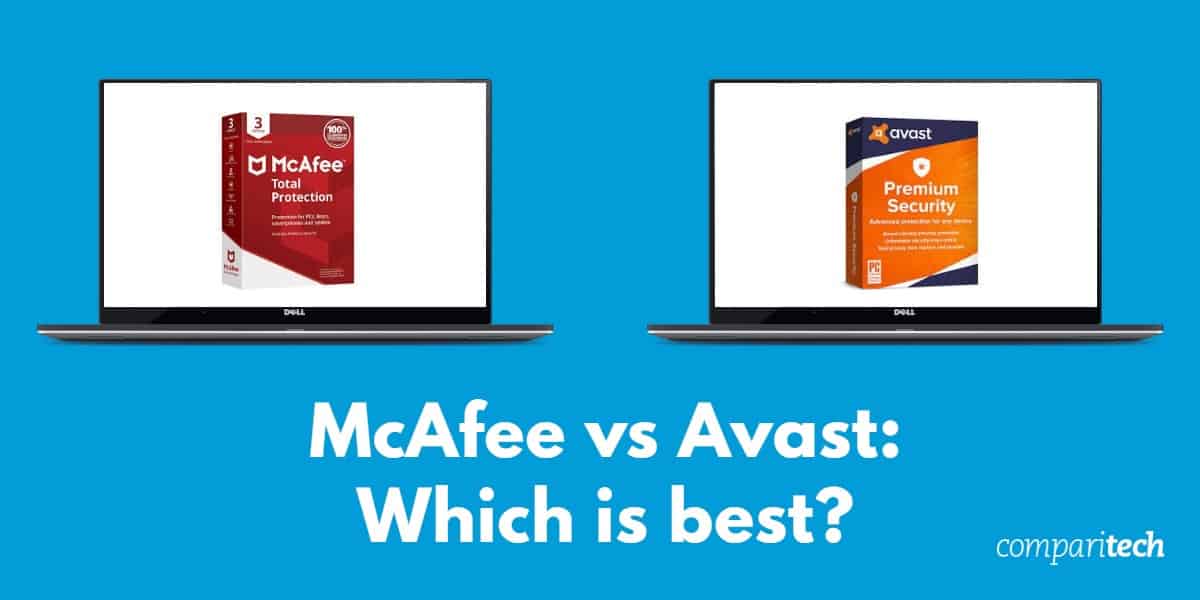
Even if you have never purchased a product from either McAfee or Avast it is likely you will have heard of both leading antivirus brands. Both companies are trusted by millions of users around the world to protect their PCs and other devices against malware threats.
Which one performs better to keep your device secure? Which provides the best additional security features? Which offers better value for money?
For this review, I will put both antivirus brands through my own testing and dive into the latest results from independent antivirus labs that routinely check and compare the top group of antivirus products for effectiveness and performance.
To ensure a fair fight, I am comparing like for like products from both companies' product ranges. I've picked McAfee Total Protection – 10 Devices and Avast Premium Security Multi-device – 10 devices. I'll put each one through its paces and give my verdict on protection against malware, value for money, additional security features, and ease of use.
If you don't have enough time to read the full comparison, here is the quick version. McAfee is my preferred choice, after recording impressive protection results in my own recent tests. It is also priced at a good value level and includes a number of useful security features like a file shredder and ID protection.
Here's what I found out on McAfee vs Avast:
Summary: McAfee vs Avast
McAfee
- File shredder
- Very low number of false alarms
- ID protection
Avast
- Excellent scores in online malware detection tests
- Ransomware protection
- Sandbox for testing files safely
- Webcam protection
| Feature | McAfee Total Protection | Avast Premuim Security |
|---|---|---|
| Antivirus and Antispyware | ✔ | ✔ |
| Firewall | ✔ | ✔ |
| Webcam Protection | ✖ | ✔ |
| Password Manager | ✔ | ✔ |
| Anti-Phishing | ✔ | ✔ |
| Ransomware protection | ✖ | ✔ |
| Banking and Payment Protection | ✖ | ✖ |
| Parental Control | ✖ | ✖ |
| Network Attack Protection | ✔ | ✔ |
| Encrypted storage | ✔ | ✖ |
| Automatically update apps | ✖ | ✔ |
| VPN | ✖ | ✖ |
| File Shredder | ✔ | ✔ |
| Performance optimization | ✔ | ✖ |
| Identity theft protection | ✔ (Included when you are enrolled in auto renewal) | ✖ |
| Run suspicious apps in sandbox | ✖ | ✔ |
Background
McAfee is one of the most well-known antivirus brands around the world and has over 7,000 employees in 189 countries. Current stats released from McAfee claim that they cover 525 million consumer internet-enabled devices such as PCs, tablets, and mobiles. McAfee was founded in 1987 and is headquartered in the United States.
Avast was founded in the Czech Republic and has grown to 1,700 employees worldwide. The company fact sheet shows that Avast currently has 425 million active users and the company's most popular markets are in the US & Canada, Brazil, France, Russia, and Germany. Some negative news broke about Avast early in 2020. Reports revealed the antivirus product had been collecting user data and selling it on through one of their subsidiaries, Jumpshot.
Pricing & Compatibility
At the time of writing McAfee has three different options for its main antivirus product, McAfee Total Protection. The only difference between the three options is the number of devices that are protected with each plan: one, five, and 10. Next up the subscription tiers is the same antivirus plus a VPN to cover five devices. Finally, McAfee offers a LifeSafe version that covers unlimited devices.
In contrast, Avast keeps its offers simple with a free basic version and Avast Premium Security for one or 10 devices. It's also worth mentioning here that Avast has launched Avast Omni in the United States. This is a total solution that protects all IoT devices via your home router and also protects mobile devices wherever you go. There is a free 90-day trial available for users in the USA (as long as your home router is compatible with the service) and then you have the option to upgrade after the trial period.
As the tables above show, McAfee subscriptions cost more in general for like-for-like subscription tiers.
One note in McAfee's favor is that it offers a discounted price for the first year of subscription, while Avast does not offer a first-year discount. Avast do offer cheaper pricing if you sign up for longer than a year, with two- and three-year subscriptions available.
Avast offers a 30-day money-back guarantee so you will need to purchase the product and request a refund if you're not happy with it. In contrast, McAfee offers a 30-day free trial so you can download Total Protection for free without a credit card.
While it may seem like the free trial from McAfee is less hassle if you want to try before you buy, I can confirm that I have used the Avast money-back guarantee and it is a simple process. I simply informed them that I no longer had a need for the antivirus and wanted to cancel within the 30 day period and was sent a full refund back to my payment card within a few days.
It's worth noting that McAfee's Total Protection does include ID monitoring and this is not included with Avast. Both McAfee and Avast are compatible with Windows PCs, iOS, Android and MacOS.
Effectiveness against malware
To establish which antivirus provides the best protection against malware, I ran my own malware tests on a PC to see how each program performed.
First, I ran a real-time test that detects malware threats as you use the PC instead of only looking for them during a scan.
Next, I ran a second type of test in which I turned off the real-time detection feature in the antivirus program, redownloaded the malware test files, and ran a scan to see the results on an already infected machine.
I used various sample malware test files from EICAR (The European Institute for Computer Antivirus Research) to test the effectiveness against malware in both antivirus programs.
I also tested the results with both a full scan and a quick scan, the latter being a lighter version of the full feature. The quick scan option does not scan the full system and only checks files in the most common areas targeted by malware.
The results below show how each antivirus performed on my PC against 3 live samples containing both trojans and adware and 4 different Eicar samples.
| Test File | Eicar Sample 1 | Eicar Sample 2 | Eicar Sample 3 | Eicar Sample 4 | Live Sample 1 (Adware) | Live Sample 2 (Trojan) | Live Sample 3 (Trojan) |
|---|---|---|---|---|---|---|---|
| Avast | Allowed | Allowed | Allowed | Allowed | Blocked | Blocked | Blocked |
| McAfee | Blocked | Blocked | Blocked | Blocked | Blocked | Blocked | Blocked |
Avast allowed the Eicar samples when downloaded over HTTPS, but blocked them on HTTP. Avast did, however, detect and delete all live samples.
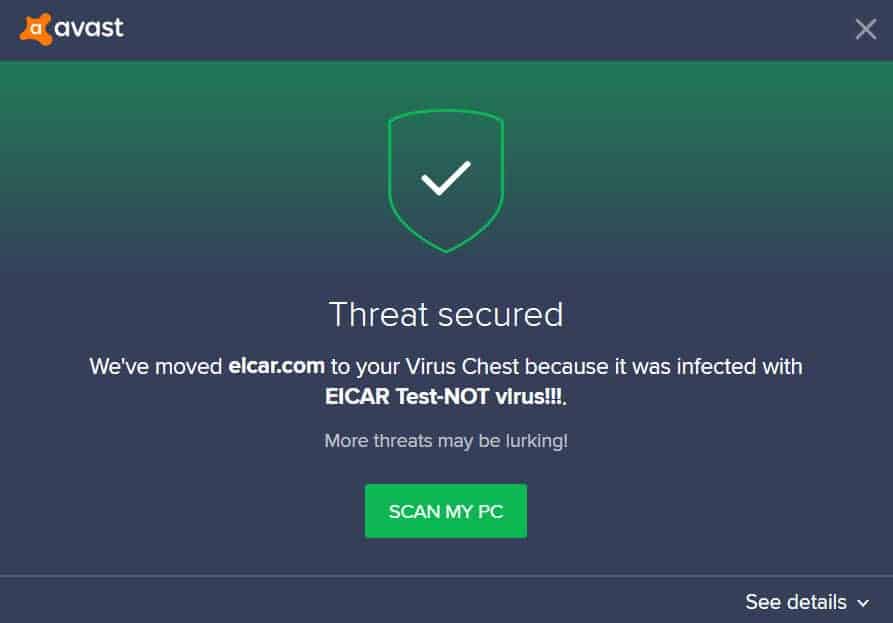
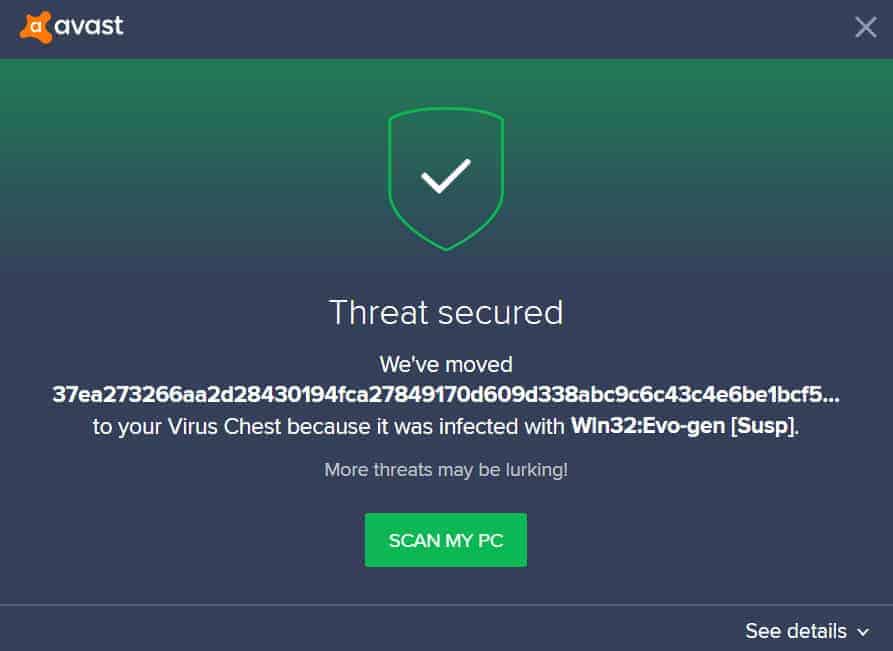
McAfee blocked all Eicar sample download attempts and blocked attempts to install live malware samples from password-protected files too.
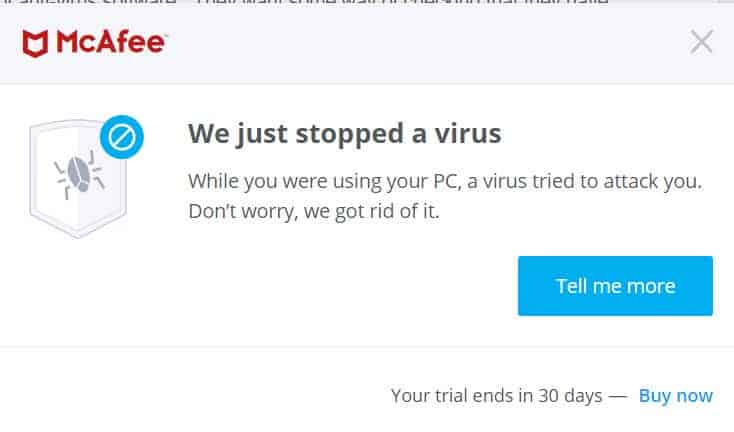
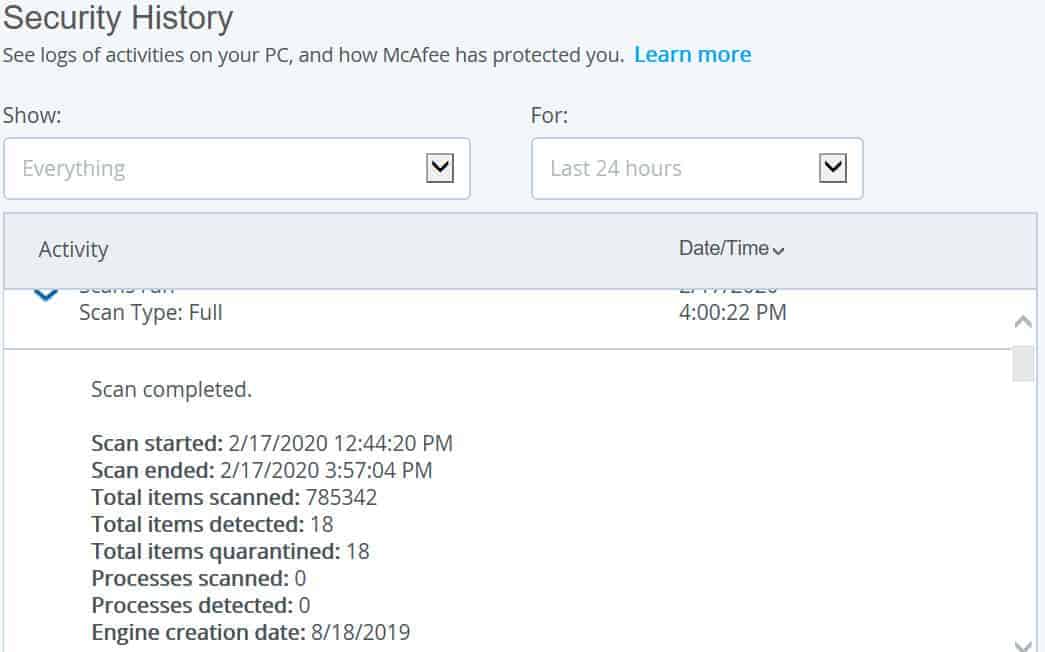
Both McAfee and Avast have a quick scan setting within the interface. Both failed to detect the Eicar and live samples in quick scan mode.
In addition to my own tests, I reviewed the latest product testing results from two respected independent test labs, AV-test and AV-Comparatives.
The latest Malware Protection Test available from AV-Comparatives was published in September 2019, giving us a recent indication of how each product is performing against malware.
McAfee scored a malware protection rate of 99.82% placing it in the bottom cluster of all antivirus products tested in this run. Avast scored better, with a perfect score of 100% protection, placing it in the top cluster of performers.
During September and October 2019, AV-Test evaluated several major security products for home users. McAfee was given a rating of 5.5 for protection, while Avast scored a perfect six for protection against PC against malware threats.
So, the numbers from independent test labs give Avast the slight edge over McAfee.
Another test run by both independent labs shows the number of times each software incorrectly identifies a file or app as a threat. The lower the number of false alarms, the better.
The test results from September show McAfee recorded just two false positives while Avast had seven.
Impact on PC performance
To test the impact of each antivirus on PC speed, I compared my own experience and recorded some numbers while running scans with both products. I also looked at some performance benchmarking tests from independent test labs.
To try out how each security suite performed on my own PC, I recorded the length of time it took to complete both a full scan and a quick scan. A full scan takes a look at every file on your machine, while a quick scan only looks at areas known to be most common for malware infections.
How long each scan takes depends on a number of factors including the number of files and volume of the data on your PC, the speed of your PC in general and the antivirus engine itself.
| Test Type | Full Scan Time (minutes) | Full Scan # Items Scanned | Quick Scan CPU Utilization % | Quick Scan Memory Utilization % | Quick Scan Disk Utilization % | Quick Scan Time (seconds) |
|---|---|---|---|---|---|---|
| Avast | 60 | 1870000 | 90 | 72 | 300 | 146 |
| McAfee | 223 | 785000 | 39 | 77 | 912 | 633 |
I ran a full scan with Avast first in a time of 60 minutes which scanned 1870000 items. In comparison, McAfee took substantially longer at 223 minutes to scan 785000 items.
Later, I ran a quick scan with both programs. Avast timed just 146 seconds to complete the quick scan while McAfee took almost 4.5x longer to perform the task at 633 seconds.
I also recorded some data to see the numbers on how my PC's resources were affected by both antivirus programs.
| Test Type | Control CPU Utilization % (no scan) | Control Memory Utilization % (no scan) | Control Disk Utilization (seconds) (no scan) | Full Scan CPU Utilization % | Full Scan Memory Utilization % | Full Scan Disk Utilization (seconds) |
|---|---|---|---|---|---|---|
| Avast | 32 | 72 | 28 | 42 | 73 | 5801 |
| McAfee | 12 | 10 | 66 | 100 | 75 | 253 |
Avast recorded higher Control CPU and Control Memory utilization, but lower Control Disk utilization when idle (not performing a scan) compared to McAfee. During a full scan Avast scored lower CPU and Memory utilization next to McAfee.
Independent AV labs' performance tests measure how installing the antivirus impacts PC performance during eight common tasks:
- Downloading files
- Browsing websites
- File copying: First & subsequent run
- Installing / uninstalling applications
- Archiving / unarchiving
- Launching applications: First and subsequent run
Each task is given a rating between very fast and slow.
AV-Comparatives Performance Test from October 2019 show that McAfee scores top marks with a rating of very fast across all tasks performed. Avast scores a rating of very fast in 7 of 8 tasks, with only the first launch of applications falling short of top marks, but still rated as fast.
AV-Test's performance results from September – October 2019 show give Avast 6.0 / 6.0 and show that the software outperforms industry averages in a number of categories. McAfee also scores 6.0 / 6.0 outperforming many industry averages when running on both a standard and high-end PC.
Comparing the performance tests, McAfee has less impact on launching popular websites, launching apps, and downloading, where it outperforms the average speeds of the antivirus industry.
Avast gets an overall rating of 5.5 for performance compared with 6.0 for McAfee, so it's not slow, but it can't match the speed of its rival.
From my personal experience, I found both products fine to use but noticed that there was virtually no drop off in terms of speed for launching applications and loading websites with McAfee in particular.
Features
The antivirus engine is the main product, but all AV brands bundle in extras to enhance PC security. Which provides the best added features, Avast Premium or McAfee Total Protection?
McAfee Total Protection
- Award-winning Antivirus
- Performance Optimization
- Home Network Security
- Security Experts and Online Support
- Multi-device Compatibility
- Password Manager
- Safe Web Browsing
- File Shredder
- Encrypted Storage
- Identity Theft Protection
Avast Premium Security
- Block viruses and other malware
- Scan for Wi-Fi security weaknesses
- Secure your passwords
- Avoid fake sites for safer shopping
- Safely run suspicious apps
- Lock out hackers with an advanced firewall
- Block annoying spam and phishing emails
- Get an extra layer of ransomware security
- Stop webcam spying
- Permanently shred sensitive files
- Automatically update apps
- Install on all your devices
Both packages share common features including password managers, compatibility with multiple devices, home wifi network protection and file shredders. In this section I think it is interesting to look at what unique features each provider offers.
I have highlighted a few of the most powerful features from each provider below with a short overview and what they do.
McAfee Total Protection
Encrypted Storage keeps sensitive files locked from intruders with 128-bit encryption.
Identity Theft Protection – This is a good additional feature that is available when you're enrolled in auto-renewal. ID Theft Protection helps you stay ahead of identity thieves with account monitoring and alerts.
Avast Premium Security
Safer shopping – Stop criminals from stealing your passwords and banking info with the Real Site feature. This tool protects from hackers who attempt to hijack your router's DNS to send you to fake sites.
Sandbox – Sandboxing allows you to open suspicious files in a safe environment before you let them run on your PC, making sure they are safe and do not pose a threat.
Automatically update apps – This tool automatically updates your apps and software by searching for the latest versions online. By keeping the most popular apps on your PC updated, you prevent security vulnerabilities and minimize opportunities for hackers.
Webcam protection – The Avast Webcam Shield feature blocks untrusted apps from accessing your webcam unless you allow them, so you always know who's watching you.
Overall, for my needs, I found that Avast had more extra features that I would like to use.
Sign up & Installation
Nobody enjoys going through a long, complicated sign-up and installation process, so thankfully most consumer antivirus products have become very easy to set up. First up, McAfee made it simple to get the product I wanted and applied the first year discount automatically to my basket. I left auto-renewal turned on to get the free ID Protection, but this can be turned off later in your account. It is important to ensure you leave auto-renewal left on if you want the free ID protection.
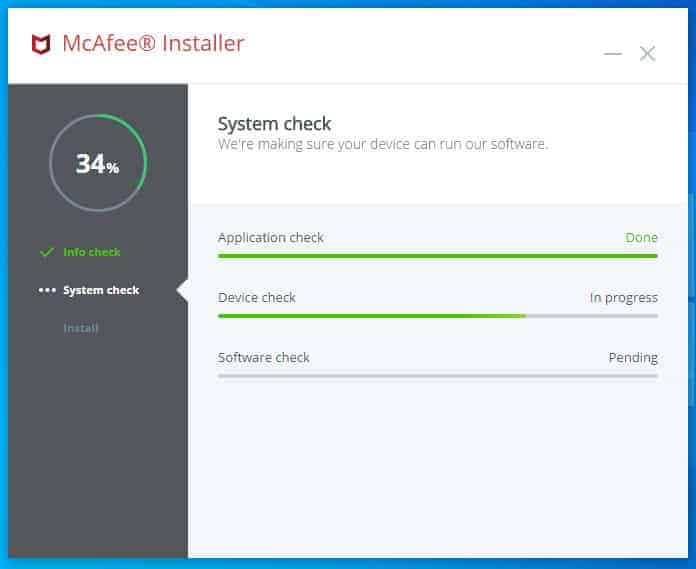
Once purchased with my payment card and a few personal details, McAfee Total Protection was installed with just a few clicks. A first run of the malware detection could be minimized to avoid distraction and let me get on with using my PC.
Avast Premium offered a similarly simple sign-up and installation, with the first scan making little distraction while I continued to use my machine.
How easy is the interface to use?
Both applications look nice and modern, but which is more intuitive to use?
Avast uses a clean and minimal design. You are welcomed with the home screen with easy access to the major tools. From here you can see your PC status, run a virus scan or a smart scan for weak passwords and vulnerable software.
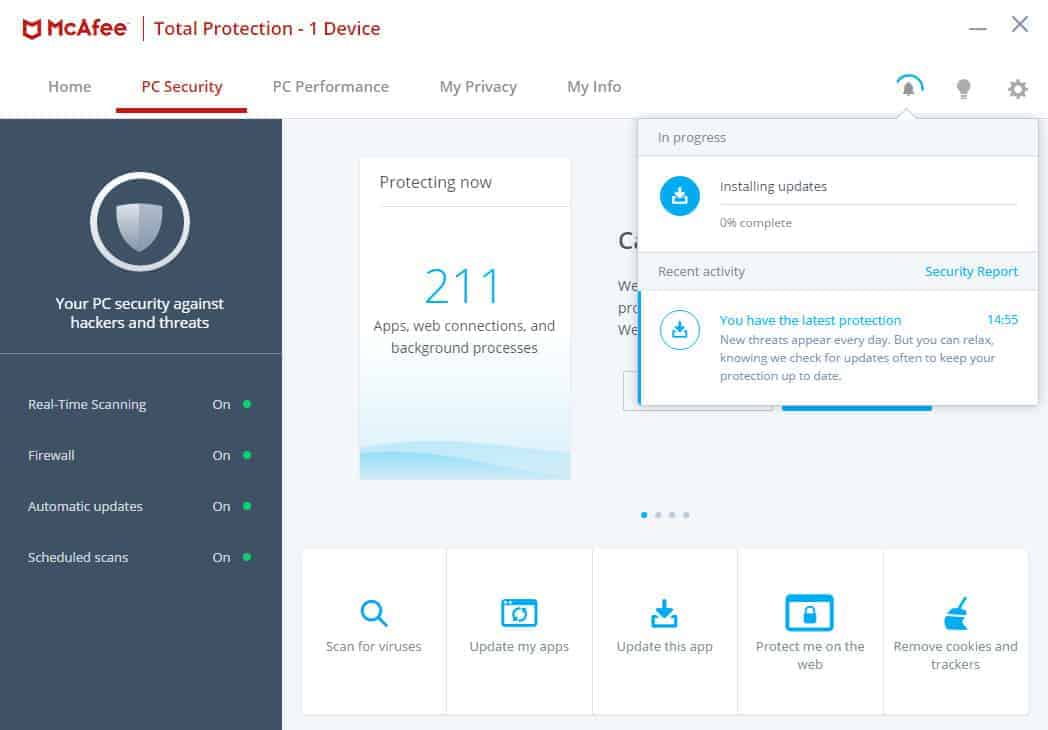
McAfee is easy to use and navigate around. The home screen shows tabs for main sections. These separate tabs take you to PC Security, PC Performance, My Privacy, and My Info.
The home screen displays a green checkmark in the upper left-hand corner to confirm that your PC is safe and secure, and the antivirus can also be accessed via an icon in the Task Tray, which is a useful shortcut.
Customer Support
Avast's support homepage splits help into popular topics including support for Installation & Activation, Refund Requests, Subscription & Account, or Sales & Billing. There are also links to a support forum and a form to report false detections.
If you need to contact a support representative, you can reach out via live chat, or email. There is a technician phone support option but this is a paid extra service. Finally, Avast provides a detailed FAQ on its website.
McAfee offers phone and live chat support. Technicians are available via these contact methods 24/7 and there is also a large online support hub with a chatbot, knowledge base, and forum. McAfee also gives users contact details for their social channels on Twitter and Facebook.
One thing I liked about McAfee's support is that they guarantee to keep your system malware-free and provide technicians to access and fix your device if needed via a secure TeamViewer session.
Conclusion
McAfee had some good wins in my comparison. McAfee Total Protection proved to have a lighter system impact than Avast and ran tasks faster than its rival. McAfee also fared better in false positives with only two errors recorded compared with seven from Avast.
The free ID Theft Protection is a very nice addon feature that is not available with Avast. McAfee also blocked all 4 Eicar samples in my own tests while Avast allowed all 4 Eicar samples when downloaded over HTTPS.
While Avast does offer some superior additional security tools including safer shopping, sandbox, webcam protection, and automatically updating apps, the malware test and performance test results, plus the news on Avast selling private data means McAfee is my winner here.
See also:
- Best antivirus
- Best antivirus for Mac
- Best antivirus for Windows 10
Which Security App Is Better Mcafree Or Avast
Source: https://www.comparitech.com/antivirus/mcafee-vs-avast/
Posted by: jacquespueed1957.blogspot.com

0 Response to "Which Security App Is Better Mcafree Or Avast"
Post a Comment